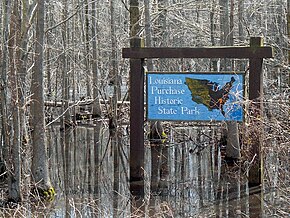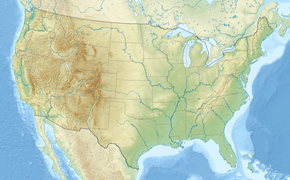
The Arkansas Post, formally the Arkansas Post National Memorial, was the first European settlement in the Mississippi Alluvial Plain and present-day U.S. state of Arkansas. In 1686, Henri de Tonti established it on behalf of Louis XIV of France for the purpose of trading with the Quapaw Nation. The French, Spanish, and Americans, who acquired the territory in 1803 with the Louisiana Purchase, considered the site of strategic value. It was the capital of Arkansas from 1819 until 1821 when the territorial government relocated to Little Rock.

Pea Ridge National Military Park is a United States National Military Park located in northwest Arkansas near the Missouri border. The park protects the site of the Battle of Pea Ridge, fought March 7 and 8, 1862. The battle was a victory for the Union and helped it gain control of the crucial border state of Missouri.
Holla Bend National Wildlife Refuge is a 7,055 acre (28.6km2) wildlife refuge located 5 miles south-east of Dardanelle, Arkansas.

The White River National Wildlife Refuge is a 160,756 acres (650.56 km2) wildlife refuge located in Desha, Monroe, Phillips, and Arkansas counties in the U.S. state of Arkansas. The refuge is managed by the United States Fish and Wildlife Service. White River NWR borders on Cache River National Wildlife Refuge at its northern boundary. In 1974, the White River Sugarberry Natural Area was designated as a National Natural Landmark by the National Park Service.

Conway Cemetery Historic State Park, officially the Conway Cemetery State Park, is the final resting place of James S. Conway, first governor of Arkansas, and his wife, Mary J. Conway. It is a 11.5-acre (0.047 km2) Arkansas state park in Lafayette County. No recreational or visitors' amenities are available at the state park.

Cossatot River State Park-Natural Area is a 5,299.65-acre (2,144.69 ha) Arkansas state park in Howard County and Polk County, Arkansas in the United States. The park follows a rough, undeveloped 12.5 miles (20.1 km) of the Cossatot River. The river itself is included in Arkansas's Natural and Scenic Rivers System and the National Park Service's list of National Wild and Scenic Rivers, making it a whitewater rafting destination. The rough nature of the river, including Class III, IV, and dangerous Class V rapids, make the park-natural area a popular destination for skilled canoeists, kayakers, and playboaters. The park became a part of the system in 1988 after the Arkansas Department of Parks and Tourism and Arkansas Natural Heritage Commission agreed to cooperative management after acquiring the property from the Weyerhaeuser Corporation.

Poison Springs Battleground State Park is an Arkansas state park located southeast of Bluff City. It commemorates the Battle of Poison Spring in the American Civil War, which was part of the 1864 Camden Expedition, an element of a Union Army initiative to gain control of Shreveport, Louisiana and get a foothold in Texas.

Lake Catherine State Park is a 2,180-acre (880 ha) public recreation area located on the south shore of Lake Catherine, eight miles (13 km) southeast of Hot Springs, Arkansas. The park was built in the 1930s by the Civilian Conservation Corps. Three stone-and-wood cabins, a former concessions building, and a bridge constructed in the Corps' rustic architecture style are listed on the National Register of Historic Places.
Millwood State Park is a public recreation area known for its fishing and wildlife habitats located along the southern side of 29,500-acre (11,900 ha) Millwood Lake, nine miles (14 km) east of Ashdown in Little River County, Arkansas.

Davidsonville Historic State Park is a 163-acre (66 ha) Arkansas state park in Randolph County, Arkansas in the United States. Situated on a border between The Ozarks and the Arkansas Delta, the park preserves the remains of the abandoned frontier town of Davidsonville. The town was one of Arkansas Territory's first settlements when founded in 1815, serving as an important river port town on the Black River. The former townsite was made into a state park in 1957 and a monument was added to the National Register of Historic Places in 1974.
Joseph Cromwell Brown was an American surveyor known for establishing the Fifth Principal Meridian's baseline that governs the surveys of all or part of present-day Arkansas, Iowa, Minnesota, Missouri, and South Dakota. The Fifth Principal Meridian was established in 1815 to survey the territory of the Louisiana Purchase, an area of 830,000 square miles (2,100,000 km2).
The Jenkins' Ferry Battleground State Park, also known as the Jenkins' Ferry Battlefield, is a battlefield in Grant County, Arkansas. The Arkansas state park commemorates the Battle of Jenkins' Ferry fought on Saturday, April 30, 1864, during the Red River campaign of the American Civil War.

Marks' Mills Battleground State Park is an Arkansas State Park located at the junction of Arkansas Highway 8 and Arkansas Highway 97, north of New Edinburg, Arkansas. It preserves a portion of the battlefield of the Battle of Marks' Mills fought on April 25, 1864, in the Trans-Mississippi Theater of American Civil War. The battle was part of the Camden Expedition. The park is one of nine historic sites that make up the Camden Expedition Sites, a National Historic Landmark District. The battle was most known for the slaughter of black Union soldiers that were murdered as they tried to surrender.

Plum Bayou Mounds Archeological State Park, formerly known as "Toltec Mounds Archeological State Park", also known as Knapp Mounds, Toltec Mounds or Toltec Mounds site, is an archaeological site from the Late Woodland period in Arkansas that protects an 18-mound complex with the tallest surviving prehistoric mounds in Arkansas. The site is on the banks of Mound Lake, an oxbow lake of the Arkansas River. It was occupied by its original inhabitants from the 7th to the 11th century. The site is designated as a National Historic Landmark.

The Fifth Principal Meridian, also known as the "5th Principal Meridian" and "PM 05", is a principal meridian survey line used in the United States for land claims in the Public Land Survey System (PLSS). It was first surveyed in 1815. The meridian, a north-south line, starts from the old mouth of the Arkansas River and runs north. Another survey line related to it is the base line running west from the old mouth of the St. Francis River. These survey lines govern all land surveys in four states and a large portion of the land surveys for two more. Monuments have been erected where the two lines meet at 34°38′44″N91°3′42″W, and the surveyors' skill has been commemorated at the Louisiana Purchase State Park in eastern Arkansas. The Fifth Principal Meridian is nearly coincident with 91° 3′ 42″ longitude west from the Greenwich meridian.
Woolly Hollow State Park is a 375-acre (152 ha) Arkansas state park in Faulkner County, near Greenbrier, Arkansas in the United States. The park was built and is based on a dam lake, Bennett Lake, built by the Civilian Conservation Corps (CCC) located at nearby Camp Halsey and Works Progress Administration (WPA) beginning in 1933. Access to the park is available from Arkansas Highway 285.
Delta Heritage Trail State Park is a 960-acre (390 ha) Arkansas state park in Arkansas, Desha, and Phillips counties, Arkansas in the United States. A rails to trails conversion planned along 73 miles (117 km) of abandoned Union Pacific right of way, the Delta Heritage Trail currently runs 14 miles (23 km) from Lexa to Barton. Acquisition of the abandoned corridor was aided by the National Trails System Act, and the beginnings of the trail through Delta lowlands was dedicated in 2002.

Logoly State Park, one of the 52 state parks of the Arkansas State Parks System, is located in the Gulf Coastal Plain, 6 miles (10 km) north of Magnolia, 0.75 miles (1.2 km) east of McNeil, off U.S. Route 79 on Logoly Road in southwestern Arkansas in the United States. The 368-acre (1.49 km2) park surrounds an area of mineral springs that have been known for over a century.

Withrow Springs State Park is a 786-acre (318 ha) public recreation area with campgrounds and hiking trails located five miles (8.0 km) north of Huntsville, Arkansas, that serves as a put-in for float trips on War Eagle Creek.


















